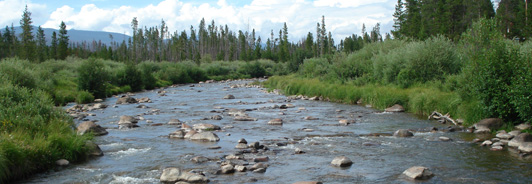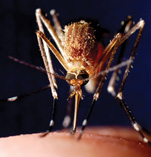Colorado’s population is expected to reach 10 million residents by 2050. The projected increase, double what it was in 2008, along with competing water needs and periods of drought will present a challenge. “Even if water providers are completely successful in implementing [planned] projects, state water experts predict that we will meet only about 80 percent of the forecasted needs in the municipal and industrial sectors by 2050,” says UNC Economics professor and water expert Mark Eiswerth, who moderated a conversation on Colorado’s water future during a campus forum. Eiswerth elaborates on the topic, including solutions being discussed, in a Q&A at northernvision.unco.edu
NV: How does winter precipitation affect Colorado's water resources in the summer?
Dr. Eiswerth: Our winter precipitation and snowpack levels play key roles in determining how much water will be available for use during upcoming summer seasons, as well as throughout the year. In Colorado, about 80 percent of surface water supplies originate from melting snowpack.
NV: What can the four main water stakeholders—agricultural, industrial, municipal and recreational users—do when confronted with an especially dry year?
Dr. Eiswerth: Generally, there are three alternatives to employ during the course of a dry year. First, agricultural, municipal and industrial users will rely to a greater extent on water storage supplies that we have accumulated in prior years, for example, in reservoirs and aquifers. However, this depends on the specific water rights of individual users—that is, exactly where they get their water. The second alternative is to use less water in a dry year (conservation). The third alternative is to transfer water from one sector to another. We have seen this in recent years in Colorado when water is transferred, in some fashion, from agricultural uses to municipal uses, either temporarily or permanently. None of these short-term options works for recreational water users who rely upon water flows in rivers and streams and who depend on current-year precipitation.
NV: Is Colorado in a drought? If so, can scientists predict how long it will last?
Dr. Eiswerth: Most scientists who follow these matters agree that Colorado is currently in its third consecutive year of drought—the worst since 1977—and its fifth year of below-average snowpack levels. Scientists have improved their ability to predict some types of trends but it still remains a very tricky business laden with a lot of uncertainty.
NV: What long-term solutions could help ease the effects of drought?
Dr. Eiswerth: In Colorado, institutions and processes have been developed to bring together different water stakeholders to discuss approaches that could reduce projected gaps between water supply and demand. At the level of river basins, there are Basin Roundtables and, at the state level, we have the Interbasin Compact Committee. These groups, with the support of the Colorado Water Conservation Board, are developing ways to better evaluate future uncertainties about water supply and demand. With these tools, they can examine how particular combinations of new water supply projects, conservation, and agricultural transfers might work to reduce water shortfalls in various scenarios, such as climate change and population growth. Although many people are working on these challenges, projected supply and demand gaps are still substantial. Even if we find a partial solution that would decrease the gap significantly, it is almost certain that not everyone would be happy with the approach.
NV: At the Community Conversation, more and bigger water storage reservoirs were discussed as a possible solution. Is this a promising and viable answer?
Dr. Eiswerth: Many who study the issue believe that, to sustain the projected levels of population growth along Colorado’s Front Range and, at the same time, minimize the dry-up of agricultural lands, it will be necessary to invest in more and bigger water storage reservoirs. In addition, building extra storage capacity helps keep more of Colorado’s water in Colorado in wet years, rather than allowing it to leave the state. Lastly, new reservoirs would offer new locations for recreation. At the same time, many citizens have concerns that new water storage projects could have adverse impacts on the rivers that would feed new reservoirs, including reduced streamflows and negative consequences for species, ecosystems, and the quality of river-based recreation. Some who oppose either new water storage or new water supply development may also have concerns that it would simply enable more population growth in Colorado, which some people oppose. Some observers are asking, “What is the maximum population that can or should be sustained in Colorado?”
NV: What does the future hold for Colorado's water? Can we "run out?"
Dr. Eiswerth: The population of Colorado passed five million in 2008, and experts expect it to double to 10 million by 2050. This growth will be a major determinant of the need for additional water.
To address increasing demands, many water providers have developed Identified Projects and Processes (IPPs). Some of these fall into the categories I mentioned earlier—new water supply projects, conservation, and agricultural transfers—but other projects involve things such as the reuse of consumable water supplies or growth into existing supplies.
However, even if water providers are completely successful in implementing all of these projects, state water experts predict that we will meet only about 80 percent of the forecasted needs in the municipal and industrial sectors by 2050. If some of the IPPs are not implemented or are not successful, then the 20 percent municipal and industrial water supply and demand gap will be even larger and will be encountered sooner. It is, or should be, the job of policymakers to strive to balance the different, and sometimes competing, wants and needs of different citizens and stakeholders.






